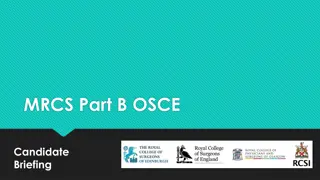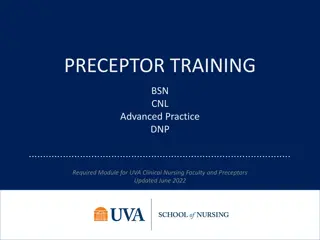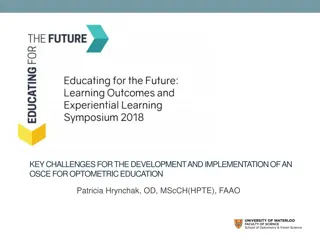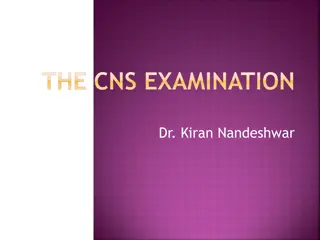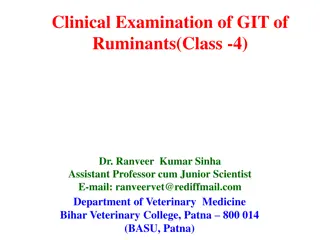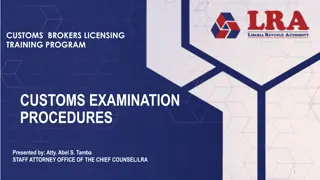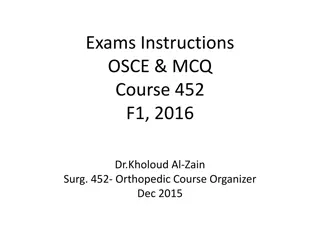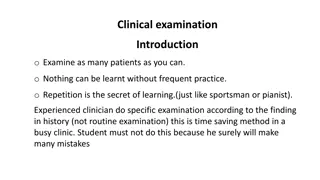Objective Structured Clinical Examination (OSCE): A Modern Approach to Assessing Clinical Competence
The Objective Structured Clinical Examination (OSCE) is a modern examination method widely used in the field of health science to evaluate clinical skill performance. It involves stations where medical students interact with simulated patients to demonstrate competencies such as history taking, physical examination, counseling, and patient management. OSCE is designed to assess competencies objectively through direct observation, where examinees perform various clinical tasks within a specific time period against formulated criteria. This performance-based teaching method measures candidates' clinical competence by observing and evaluating their interactions with standardized patients across different stations.
- OSCE
- Objective Structured Clinical Examination
- Clinical Competence
- Modern Evaluation Method
- Health Science
Download Presentation

Please find below an Image/Link to download the presentation.
The content on the website is provided AS IS for your information and personal use only. It may not be sold, licensed, or shared on other websites without obtaining consent from the author. Download presentation by click this link. If you encounter any issues during the download, it is possible that the publisher has removed the file from their server.
E N D
Presentation Transcript
WHAT IS OSCE? OBJECTIVE STRUCTURED CLINICAL EXAMINATION
INTRODUCTION The OSCE can be highly successful as an instrument to assess competence in medicine and the approach has many advantages over more traditional methods It is a modern type of examination often use in health science. It is design to test clinical skill performance
(Cont..) It described as time based examination in which medical students interact with series of stimulated patients in stations that may involve history taking, Physical Examination, counselling or patient management.
(Cont..) It assesses competency, based on objective through direct observation. it is comprised of several stations in which examinees are expected to perform a variety of clinical tasks within a specific time period against formulated criteria.
DEFINITION OF OSCE OSCE is performance based teaching used to measures candidate s clinical competence. During OSCE, candidates observed and evaluated as they go through a series of stations in which they interview, examine and treat standardized patients who present with some type of medical problems
HISTORY OF OSCE OSCE was developed in Scotland in the early 1970 s by Dr. Hardening Colleagues. The OSCE is now used in over 50 country world-wide In Canada a National OSCE, taken by all medical school which is considered as largest OSCE.
WHAT DOES OSCE STANDS FOR?
O- OBJECTIVE The candidates are assessed exactly in the same situation with the same stimuli and evaluated with same marking scheme. Candidates get marks/points for their performance/ answer. This makes the assessment of clinical skills more objective rather than subjective.And the performance is evaluated with the standardized checklist
S-STRUCTURED Each student get same time frame to complete the task. Specific foundational and functional competencies are tested at each stations and the making scheme for each station is structured OSCE should carefully designed/structured to include all elements of the curriculum
C- CLINICAL The tasks are the representative of those, the candidates faced in real clinical situations. The candidates will get stimulated clinical situation were they need to apply their theoretical knowledge. An OSCE is designed to apply both clinical and theoretical knowledge
PURPOSES OF OSCE Measures clinical skills. Promote structured interaction between students and examiner Make structured marking scheme possible Present all candidates for same test Promote objectivity
USES OF OSCE Generally the following range of practical skills are typically assessed in nursing using OSCE: Interpersonal and communication skills History taking skills Physical examination of specific body system Mental health assessment Clinical decision making, including the formation of differential diagnosis Clinical Problem solving skills
(Cont..) Interpretation of clinical findings and investigations Management of clinical stations, including treatment and referral Patient education Health promotion Acting safely and appropriately in an urgent clinical situations Basic and advanced nursing care procedure practices.
ADVANTAGES Provides an opportunity to test a student s integrate ability like knowledge, clinical skills, and communication ability Provide an occasion for individualized evaluation and feedback Offer an additional parameter to evaluate student performance It is best tool for summative assessment Allow for assessing complex competencies without compromising patients well-being Fun activity within the department or college, which promotes team work
(Cont..) Provide valuable information/feedback for curriculum review The examiner can control the complexities of the examination Components of clinical skills & standard of competencies to be evaluated are predetermined so objectives & reliability is higher
DISADVANTAGES Knowledge and skills are tested in compartment & not tested in ability to look at the patient as a whole. The OSCE may be demanding for both examiners and patients. So it demands more human resources Shortage of skill qualified examiners Development and administration are time consuming and costly
MAJOR REQUIRNMENTS FOR OSCE Standardized patients (SP) Stations Marking Scheme
COMPONENTS OF OSCE The examination coordinating committee The examination coordinator Lists of skills, attitude and behaviours to be assessed Criteria for scoring the assessment The examinees The examiners Examination station
(Cont...) Examination stations: Time and time allocation between stations Anatomic models for representative examination couplet stations examination questions environment of exam stations examination station circuit Patient real or stimulated
(Cont...) Time keeper/time clock Contingency plans Assessment of the performance of osce Viva/voice oral examination
ORGANIZING THE OSCE The OSCE examination consist of about 10-15 stations , each of which requires about 4-5 minutes. The numbers of stations and time spent on each stations may vary on the based on needs of evaluations All stations should be capable of being completed in the same time The students are rotated through all stations and have to move to he next stations at the signal As the stations are generally independent, student can start at any procedure stations and complete the cycle
(Cont...) each station requires 4 to 5 mints 15 students can complete the examination within 1 hour each station designed to test a component of clinical competence at some stations, called the procedure stations, students are given tasks to perform on patients or stimulators at all stations there are observers with agreed upon checklist or rating scales to score the student s performance at other stations called response stations, student respond to questions of the objective type or interpret data or record their findings of the previous procedure stations.
The Examination Coordinating Committee The Examination Coordinating Committee An examination coordinating committee is made up of members who are committed to the evaluative and educational process and whether appointed or volunteered must give this effort high priority in order for the OSCE to be developed and implemented. It is the responsibility of the examination committee to determine the content of the examination, development and implementation
The Examination Coordinator The functions of the examination coordinator (M.D. or Ph.D. educator) are the catalyst that facilitates the smooth working of the committee in developing, implementing and assessing the performance of the OSCE
Lists of Skills, Behaviours and Attitudes to beAssessed The examination will measure objectively the competencies in specific areas of behaviour, techniques, attitudes and decision-making strategies based on the objectives of the course or the requirement of the licensing body. The OSCE should be able to reliably assess clinical competence in history taking, physical examination, laboratory, radiographic and other data interpretation, technical and procedural skills as well as counselling and attitudinal behaviours
Criteria for Scoring theAssessment (Marking Scheme or Checklist) A marking scheme or checklist is preparedfor each station. Preparation of the checklist requires predetermined objective criteria that are agreed upon by the examination committee, based on faculty input. scheme/checklist unambiguous and written to contribute to the reliability of the station Marking should be concise,
Rating j
The Examinees The examinee is the student, resident, or fellow in training or at the end of training of a prescribed course designed to teach certain clinical competencies that the examinee can use in a clinical situation to make an assessment and develop a diagnostic formulation that culminates in a therapeutic plan.
The Examiners Most stations will require an examiner, although some stations do not. The examiner at the station where clinical skills (history-taking, physical examination, interviewing and communication) are assessed, may be either a physician or a standardized patient
The Examination Site The examination site is part of a special teaching facility in some institutions. When such facilities are not available, the examination may be conducted in an outpatient facility or other space where offices are available in close proximity to each other.
Examinations Station The total number of stations will vary based on a function of the number of skills, behaviours and attitudinal items to be tested. .Time Allocation and Time between Stations The competency being assessed in particular station will define how much time should be allotted per station. The length of time will range from 5-20 minutes. The time allocated per station should be as uniform as possible thus facilitating the smooth movement of examinees from station to station 1.
Couplet Station Some competencies may best be assessed by coupled or linked stations. For example, a couplet station may consist of a history- physical examination combined with a problem-solving station.
Examination Questions Examination questions are designed to assess the ability to interpret information and critical thinking. The questions deal with diagnostic investigations, differential diagnostic and management plans.
Patient (Real) or Simulated A standardized patient is an individual with a health problem that is in a chronic but stable condition. Standardized or simulated patient may be used when properly trained for history and physical assessments. Simulated patients may come from the ranks of volunteers, or acting guilds.
Timekeeper, Time Clock and Time Signal Appropriate personnel for the position of official timekeeper and exam facilitators need to be identified and properly instructed. Awell functioning time clock and time signal are critical. One support person per three stationsis recommended.
Conclusion The OSCE has several distinct advantages. In view of these, the nurse educators can adopt it as an objective method for clinical evaluation. This will help the students to improve their clinical competence. The emphasis is on assessing what students can do rather than what they know. Therefore, OSCE gives direction for attaining the ultimate aim of the teaching- learning process.







